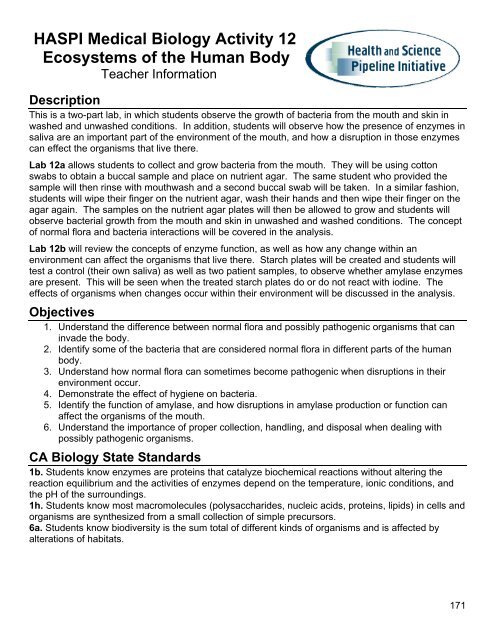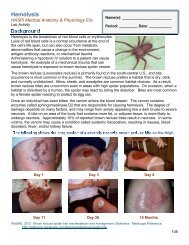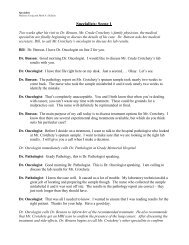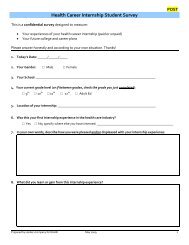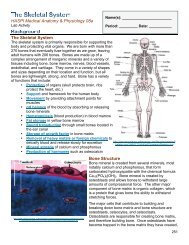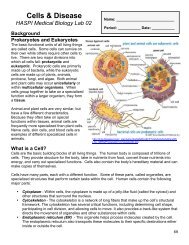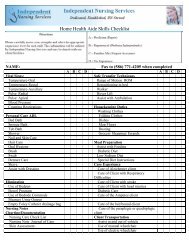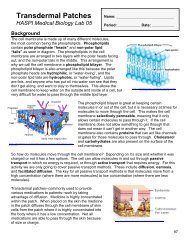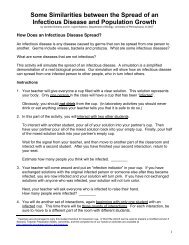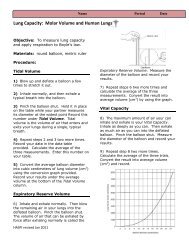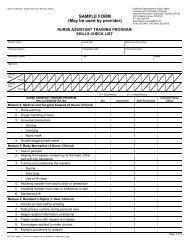You also want an ePaper? Increase the reach of your titles
YUMPU automatically turns print PDFs into web optimized ePapers that Google loves.
HASPI Medical Biology Activity <strong>12</strong><strong>Ecosystem</strong>s of the Human <strong>Body</strong>Teacher <strong>Info</strong>rmationDescriptionThis is a two-part lab, in which students observe the growth of bacteria from the mouth and skin inwashed and unwashed conditions. In addition, students will observe how the presence of enzymes insaliva are an important part of the environment of the mouth, and how a disruption in those enzymescan effect the organisms that live there.Lab <strong>12</strong>a allows students to collect and grow bacteria from the mouth. They will be using cottonswabs to obtain a buccal sample and place on nutrient agar. The same student who provided thesample will then rinse with mouthwash and a second buccal swab will be taken. In a similar fashion,students will wipe their finger on the nutrient agar, wash their hands and then wipe their finger on theagar again. The samples on the nutrient agar plates will then be allowed to grow and students willobserve bacterial growth from the mouth and skin in unwashed and washed conditions. The conceptof normal flora and bacteria interactions will be covered in the analysis.Lab <strong>12</strong>b will review the concepts of enzyme function, as well as how any change within anenvironment can affect the organisms that live there. Starch plates will be created and students willtest a control (their own saliva) as well as two patient samples, to observe whether amylase enzymesare present. This will be seen when the treated starch plates do or do not react with iodine. Theeffects of organisms when changes occur within their environment will be discussed in the analysis.Objectives1. Understand the difference between normal flora and possibly pathogenic organisms that caninvade the body.2. Identify some of the bacteria that are considered normal flora in different parts of the humanbody.3. Understand how normal flora can sometimes become pathogenic when disruptions in theirenvironment occur.4. Demonstrate the effect of hygiene on bacteria.5. Identify the function of amylase, and how disruptions in amylase production or function canaffect the organisms of the mouth.6. Understand the importance of proper collection, handling, and disposal when dealing withpossibly pathogenic organisms.CA Biology State Standards1b. Students know enzymes are proteins that catalyze biochemical reactions without altering thereaction equilibrium and the activities of enzymes depend on the temperature, ionic conditions, andthe pH of the surroundings.1h. Students know most macromolecules (polysaccharides, nucleic acids, proteins, lipids) in cells andorganisms are synthesized from a small collection of simple precursors.6a. Students know biodiversity is the sum total of different kinds of organisms and is affected byalterations of habitats.171
Time: Lab <strong>12</strong>a: 45-50 minutes over 1-3 days, Lab <strong>12</strong>b: 35-40 minutesLab <strong>12</strong>a will require the teacher to make 10 nutrient agar plates before the lab. Follow the directionson the nutrient agar packet. You may consider having the students make their own plates. Gatheringthe samples and placing them on the plate will take approximately 20-30 minutes. The plates willthen either need to be placed in an incubator for students to look at the following day, or can be keptat room temperature and observed 2-3 days later. Observation and analysis will take 20-25 minutes.Lab <strong>12</strong>b will also require the teacher to make the 10 gelatin starch plates before the lab. Follow theincluded directions. You may consider having the students make their own plates. Placing thesamples on the starch plates will take approximately 5 minutes. The students must then wait 15minutes for the reaction to occur. After 15 minutes they will flood the plate with iodine. The plate willturn blue, except in the areas where amylase broke down the starch. Analysis will take 15-20minutes.Materials Supplies needed for 10 lab groupsLab <strong>12</strong>a: Bacteria of the <strong>Body</strong>SupplyProvided (P) orNeeded (N)QuantityPetri plates P 10Nutrient agar P 1 packetUnsterile swab applicators P 20Mouthwash N 50 mlSoap N 1Water N 100 mlBeaker N 1Heating source N 1IMPORTANT: Check the MSDS for safety information on unfamiliar chemicalsLab <strong>12</strong>b: The Oral EnvironmentSupplyProvided (P) orNeeded (N)QuantityPetri plates P 10Gelatin mix P 30 gStarch, corn powder P 50 gPatient sample A P 5 mlPatient sample B P 5 mlIodine P 50 mlWater N 100 mlBeaker N 1Heating source N 1IMPORTANT: Check the MSDS for safety information on unfamiliar chemicalsHASPI Medical Biology Lab <strong>12</strong>, <strong>Body</strong> <strong>Ecosystem</strong>, Teacher <strong>Info</strong>; Revised July 2011 172
Additional <strong>Info</strong>rmationDissolve the contents of the nutrient agar packet in 100 ml of distilled water. Mix thoroughlyand allow to stand about 5 minutes. Boil for 1 minute and dispense into plates.The nutrient agar can be easily made in the microwave. Make sure to place lids immediatelyon plates to prevent contamination. These plates will not be 100% sterile, but should stillprovide accurate enough results to relay the objectives.Patient A sample is actually biotene, which is a synthetic saliva that can be purchased at anydrugstore. Patient B sample is water with a small amount of soap.You may choose to have the students use different mouthwashes and different soaps to do aclass wide comparison.Kit Replenishment Instructions- HASPI Supported Sites OnlyFunds permitting, HASPI will replace annually: Petri plates Nutrient agar Unsterile swab applicators Gelatin mix Starch, corn power Patient sample A (MUST return bottle for refill) Patient sample B (MUST return bottle for refill) Iodine (MUST return bottle for refill)Resources and References Douglas, C.W., Heath, J., and Gwynn, J.P. 1992. Enzymic activity of salivary amylase whenbound to the surface of oral streptococci. Department of Oral Pathology, University ofSheffield. FEMS Microbiology Letters, 92:2; pp193-197. NHGRI. 2009. Study Finds Unexpected Bacterial Diversity on Human Skin. NationalInstitutes of Health, National Human Genome Research Institute.http://www.genome.gov/27532034 Sheila Krotz, Mouth Enzyme Lab, San Ysidro High School, 2011. Heather Peterson, HASPI Curriculum Coordinator. www.<strong>haspi</strong>.org Edited by Janet Hoff-Kneier, HASPI Program Manager. www.<strong>haspi</strong>.orgImages (in order of appearance) http://commonfund.nih.gov/hmp/index.aspx http://www.somespacegallery.com/html/2008/august.html http://www.gadgetscience.com/wp-content/uploads/bacteria-300x223.jpg http://textbookofbacteriology.net/growth_2.html http://www.cdrommu.org/tag/mouthHASPI Medical Biology Lab <strong>12</strong>, <strong>Body</strong> <strong>Ecosystem</strong>, Teacher <strong>Info</strong>; Revised July 2011 173
HASPI Medical Biology Lab <strong>12</strong>, <strong>Body</strong> <strong>Ecosystem</strong>, Teacher <strong>Info</strong>; Revised July 2011 174


